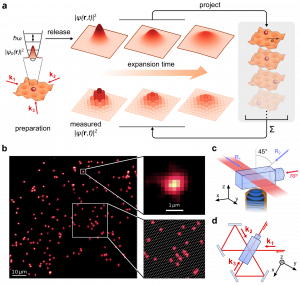Imaging Atoms in Quantum Wave Motion
Physicists at the Laboratoire Kastler Brossel in Paris have developed a powerful new technique for directly observing the wave-like behavior of individual atoms as they move through space. By precisely controlling ultracold atoms with lasers and imaging them with a state-of-the-art microscope, the researchers have captured some of the clearest evidence yet of matter waves in action. Their findings, published in a recent pre-print, provide an exciting glimpse into the mysterious quantum world of single particles.
All particles have both particle-like and wave-like properties according to the strange rules of quantum mechanics. At the scale of atoms and smaller, objects subtly behave as waves even as they remain distinctly countable particles. Past experiments have indirectly studied matter waves through scattering effects, but directly imaging individual atomic waves has proved challenging. The French team sought to change that by developing a method to smoothly project atomic wavefunctions onto an optical lattice and then pinpoint atomic positions with single-particle imaging.
Preparation and in-situ imaging of single-atom wave packets. (a) Measurement scheme: Individual atoms are prepared close to the harmonic oscillator ground state of individual sites of a triangular optical lattice created by a self-interfering laser beam with wave vectors 𝐤𝟏, 𝐤𝟐 and 𝐤𝟑. Wave packets initially trapped in the lattice wells, characterized by a Gaussian probability density distribution |𝜓0(𝐫)|2 , are released in a plane, allowing them to expand for a given time. For imaging after expansion, the lattice is quickly ramped up again, projecting the wave packet, and Raman sideband cooling is applied to pin the atom on a single site. Resulting atomic positions are recorded through site-resolved fluorescence imaging. From many repetitions of identically prepared wave packets we create histograms of the projected positions with a discretization given by the lattice structure, resulting in a measured probability distribution |𝜓0(𝐫)|2. (b) Experimental single-atom resolved image. The top-right panel shows a subregion containing an individual atom. The bottom-right panel displays an enlarged region of the image over which the reconstructed triangular lattice structure with a spacing of 𝑎𝐿=709 nm is shown as white dots. (c) Experimental configuration of the oblate optical dipole trap confining the atoms to a two-dimensional plane, the Raman beams (R1, R2 and RP) used for cooling and imaging, and the microscope objective. (d) Top view of the experimental configuration, showing the geometry of the optical lattice beam.
Their results give credibility to a daring conjecture – that at macro scales, the entire universe may be understood as a grand energy wave of matter, and our perception of reality is just the conscious interpretation of this constant quantum flux. Atoms, people, planets, galaxies – all could be described as recurrent probabilistic patterns within an endless cosmic motion. Nothing truly stays still according to this perspective, explaining why physicists have never found absolute rest in their investigations of nature.
By granting a window into elusive quantum wavefunctions, this work brings us one step closer to fully visualizing the quantum world. In capturing some of the clearest images yet of particles obeying their dual wave-particle nature, the French researchers have taken atomic quantum microscopy to a new level. Their results provide a stunning confirmation of the quirky rules of quantum mechanics and open exciting avenues for direct discovery at the deepest scales of nature.
Reference(s)
- UK company sends factory with 1,000C furnace into...on December, 2025 at 12:26 am
- Blue Origin astronaut reveals depression after...on December, 2025 at 12:26 pm
- Great white sharks face extinction in...on December, 2025 at 1:15 am
- BBC taken to secret location in Welsh mountains...on December, 2025 at 12:26 pm









